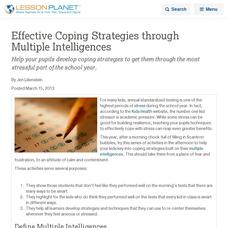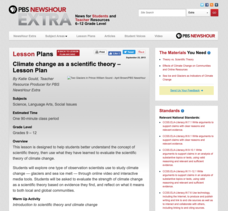Curated OER
New York State Testing Program English Language Arts Book 3--Grade 8
In this New York State Testing Program English Language Arts worksheet, students read a story and a poem and answer reading comprehension questions. Students then compose an essay using details from both selections.
Curated OER
Take Note: Five Lessons for Note Taking Fun
Students practice note-taking skills through a variety of activities and exercises.
Curated OER
New York State Testing Program: Mathematics Test Grade 3
In this grade 3 math test worksheet, 3rd graders complete a total of 31 problems covering a wide variety of grade 3 match concepts.
Curated OER
New York State Testing Program: Mathematics-Grade 4
In this New York testing program worksheet, 4th graders complete a total of 39 problems that cover a wide variety of 4th grade math concepts.
Curated OER
New York State Testing: English Language Arts Grade 3
For this New York state grade 3 language arts test, 3rd graders complete 21 multiple choice questions, reading passages and complete questions that follow each.
Curated OER
New York State Testing Program: Mathematics Grade 5
In this New York state grade 5 math test, 5th graders complete a set of 26 problems covering a wide variety of 5th grade math concepts.
Curated OER
Introduction to Scientific Theory
Ninth graders explain how scientists set up investigations. For this scientific process lesson, 9th graders review the principles of the scientific method and use these skills to answer an open-ended question about how to set up a...
Curated OER
You want me to do what with this Dirt?
Eighth graders explore how to take soil samples and use GPS to determine the location of the site they have chosen to take the samples.
Curated OER
Effective Coping Strategies through Multiple Intelligences
Help your pupils develop coping strategies to get them through the most stressful part of the school year.
Curated OER
Georgia CRCT - 7th Grade Language Arts Quiz
Whether your seventh graders are preparing for the Georgia Criterion-Referenced Competency Test (CRCT) or any other standardized test, this practice worksheet takes them through a variety of language arts skills. Punctuation, grammar,...
Virginia Department of Education
A-Mazing Plants
Have your young scientists questioned why plants grow a particular way? Through this learning opportunity, scientists gain firsthand knowledge about how plants develop and various factors that affect rates of growth as they bring plants...
Virginia Department of Education
States of Matter
Scientists have been studying exothermic reactions before they were cool. The lesson begins with a discussion and a demonstration of heat curves. Scholars then determine the heat of fusion of ice and the heat needed to boil water through...
Virginia Department of Education
Genetic Variation and Mutations
Young scientists demonstrate their creativity while completing several activities, to assess genetic variations and mutations. Instructors provide a list of options and scientists choose to write a comic strip, create a book, construct a...
Virginia Department of Education
Composition of Functions
Analyze functions by decomposing complex functions and composing simple functions. Through a detailed lesson plan, pupils learn the vocabulary and notation related to the composition of functions. Practice includes both evaluating and...
Virginia Department of Education
Determining Absolute Age
How can radioactive decay help date old objects? Learners explore half-life and radioactive decay by conducting an experiment using pennies to represent atoms. Young scientists graph data from the experiment to identify radioactive decay...
Virginia Department of Education
Surface Area and Volume
Partners use materials to wrap three-dimensional objects to determine the formula for surface area. The groups use an orange to calculate the amount of peel it takes to completely cover the fruit. Using manipulatives, individuals then...
Education Development Center
Choosing Samples
What makes a good sample? Your classes collaborate to answer this question through a task involving areas of rectangles. Given a set of 100 rectangles, they sample a set of five rectangles to estimate the average area of the figures. The...
Scholastic
Study Jams! Volcanoes
You will lava this little clip about volcanoes! It explains what a volcano is and describes the four different types. It also addresses how magma flows through a conduit, passes through a vent, and becomes lava. All of this takes place...
Captain Planet Foundation
Shape Shifters in the Math Garden
Combines mathematical measurement with gardening skills. Third graders hunt for worms in the garden and try to find the longest one. They also measure and weigh vegetables that they harvest from the garden, measure rainfall amounts, and...
It's About Time
Renewable Energy Sources - Solar and Wind
There has been a huge solar energy spill! Let's go outside to play in it. This lesson includes multiple experiments showcasing solar and wind energies. Scholars build a solar heater and an anemometer before testing the results. The...
Scholastic
Study Jams! The Nervous System
Get your class thinking with animations of neurons in action and explanations of how stimuli is transported and processed. This film makes an ideal introduction or review of the nervous system. The parts of the brain and what they...
Historical Thinking Matters
Spanish-American War: 3 Day Lesson
Why did the United States choose to invade Cuba in 1898? As part of a 3-day lesson plan, your young historians will first develop working hypotheses to answer this question, then work with a variety of historical primary source documents...
NASA
Producers Make Their Own Food
During an inquiry-based lesson, scholars decide which variable to test and then design an experiment to determine the needs of producers. After two weeks, they complete a full analysis and research paper.
PBS
Climate Change as a Scientific Theory
Get your class thinking about climate change as a scientific theory. Guided by a handout, emerging earth scientists read articles and take notes about glaciers and sea ice. To conclude, they write an evaluation of the evidence for...
























